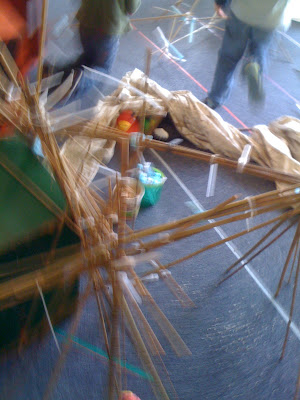Shortly after we'd undertaken to build our new outdoor classroom, Pastor Judy of the Fremont Baptist Church, whose office overlooks the space, told me, "Ever since you started doing all this, there have been a lot more birds out here."
We'd all noticed the "wildlife," at least in contrast to our previous space. It's mostly crows and squirrels, of course, but also some stellar jays, sparrows, and robins as well, not to mention an abundance of insects, like the large black ants that swarm across the ground. Maybe not the best place for a picnic, but perfect for curious young minds and fingers.
Not so much for our attempts at gardening, however. Ultimately, we intend for our garden to be located on the other side of the church, but for the summer Jody's mom Jennifer built us a set of raised beds from lumber she salvaged from the old place.
I thought a scarecrow would be a fun project, even if it didn't intimidate the crows. After all, we'd made one at the old place and it had turned out to be a creative construction project for a day. What I'd forgotten about that previous scarecrow is that the idea for it had emerged from the children, not from Teacher Tom.
I also decided that we could employ the bamboo cane and zip tie construction technique we'd so successfully explored last Fall, not remembering that we had explored those materials for several days before we were up to launching into an actual project.
In other words, it was an adult-generated project, using a construction technique for which most of the kids weren't sufficiently experienced, which explains why our parent-teacher at the workbench that day (Malaika and Liam's mom Phillipa) had to work so hard to get the kids involved. Typically, when that happens, I leave the instruction to just get going and make room for the kids to pitch in where they will and can. Phillipa worked hard to lure the kids in, but I think she did most of the construction work herself, including dressing the framework she'd built, although the kids took an interest in decorating the styrofoam head I'd made available for the purpose, then proceeded to apply paint to the straw hat and pants in a last minute flurry of finally claiming a bit of ownership.
The board and tangle of string leaned there against the scarecrow's leg
was a subsequent addition, that will have to be explained in a future post.
Building the scarecrow wasn't a complete disaster, after all, but also not one of those great moments in preschool history, which is kind of the story of much of what transpires in a play-based classroom. Still, we built a scarecrow, the kids had a certain amount of fun making it, and those that participated seem to feel at least a small degree of ownership, even if it's only that they know the story of how it got there.
A far more enduring a legacy of this project has been the introduction of those bamboo canes to the outdoor classroom. They're the type of cane sold for staking things up in the garden, the same ones that were the perfect size and weight for our spear throwing experiments.
I've been doing this long enough to know that in a place that hosts 2-year-olds, it can be rather hazardous to have lots of long, pointy sticks laying about. It seems that their favorite thing to do with them is to wave them around in other people's faces, especially near the eyes. This doesn't mean that we forbid such objects, but during the normal school year, when the same kids are coming week after week, we have the opportunity to teach them how to respect long, pointy sticks; how to carry and use them safely in their play. It's a teaching process that typically requires many days, a luxury we don't have in the summer.
As Phillipa and a small gaggle of kids worked on the scarecrow, many of the remaining bamboo canes were commandeered for other purposes, like fishing poles and wands, but most often, I'm afraid, swords. I did not take the canes from children, although I did quite often find myself "taking hold" of them as we talked through the potential hazards of using them this way versus that way. After all, the children were finding a way to make the adult-generated project their own and it's my job, in a play-based curriculum, to make it possible for them to do that without hurting themselves or their friends. That's not to say that when I found a cane abandoned on the ground, I didn't gather it up and return it to the workbench, but at the end of the day, there were canes scattered across the space.
When the children were gone for the day, I did my best to collect the canes, stashing them back into our storage area where I told myself they would remain until the start of the regular school year when they could be introduced in a more controlled manner.
The problem with these canes, however, is that they camouflage themselves very nicely against our wood chip covered ground, as well as amongst the like-sized lilac stems, so over the course of the next few days, the bamboo canes turned up here and there. I would thank the kids for finding them, wait until they dropped them on the ground, then discretely put them away.
Ah, but unbeknownst to me, I was not the only one on this mission. Last week, more than a week after our scarecrow project, I poked my nose into one of the the lilac forts as I prepared for our day, and what did I discover?
That's right, a stash of at least a dozen bamboo canes, hidden away like treasures in the one place the adults rarely go. I'd seen no evidence of them for several days, concluding I'd gathered them all up. It was a secret, I suspect, the older children were keeping amongst themselves, one they were keeping even from the younger kids because otherwise they would have been waving them about in people's faces, drawing attention from the adults.
I chose to leave them where I'd found them. Over the course of the day, I spied one or two in the hands of a few of the older boys, furtively, evident for a moment, then taken back into hiding. I'm sure they were swords because the game of the day was pirates.
The children still don't care that the squirrels and crows are eating our seeds and they are only mildly interested in the scarecrow, but indeed, as they so often do, they got the adult out of the way so they could make my stupid scarecrow project their own. Now my job is to try to keep up.



















































